Including ... • A Gathering of Sheepdogs • President’s Message • Book Review • Remembering Jim Cirillo • Tactical Flashlights • Editor's Notebook
Get eJournal PDF: click here
A Gathering of Sheepdogs…
by Marty Hayes, J.D.
According to Lt. Col. David Grossman, author of the groundbreaking book “On Killing,” there are three types of people, characterized as sheep, wolves, and sheepdogs. He writes “most of our society are sheep, incapable of hurting or killing someone except by accident. The wolves are the predators of our society, and feed on the sheep. Then, there is the sheepdog, the protector of the sheep, to keep them safe from the wolves.” I felt I was with society’s “sheep dogs” recently when I had the honor of attending my third Rangemaster Tactical Conference, held in Memphis the last weekend of February. Tom Givens, owner of the Rangemaster indoor shooting range and an advisory board member for the Network, puts together this tactical conference each year. This time, he invited me to come and discuss the Network with the 150 or so participants and I jumped at the chance.
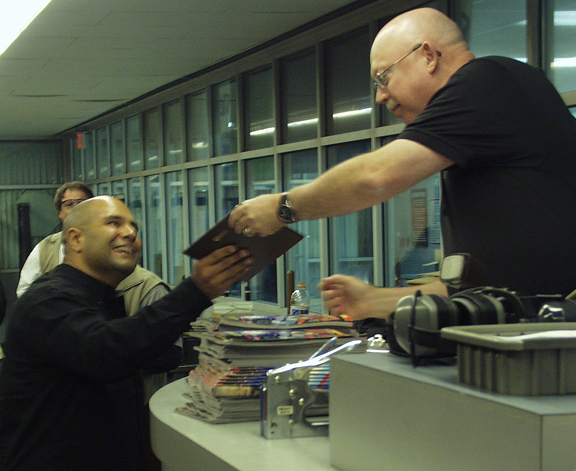 Although the Tactical Conference is one of my favorite industry gatherings, I had been unable to participate for the last four years due to law school demands, though I’d been part of two of these great events earlier. I found the 2008 conference as educational and energizing as before, with a superb line-up of heavy hitters presenting classes and attending. Presenting this year (in no particular order) were Mike Warsocki, Skip Gochenour, Paul Gomez, Andy Stanford, William Aprill, John Hearne, John Farnam, Randy Harris, TJ Pilling, Hany Manmoud, James Yeager, Mike Brown, SouthNarc, Karl Rehn, Claude Werner, Steve Moses, Rob Pincus and Will Andrews. These gentlemen represent many of the top firearms training schools in the nation, and all volunteer their time and travel, to accomplish two things. One, is to expose their school to others who might not otherwise come to know them, and the second, is to train with each other, pick one anothers’ brains, and get new ideas for their own classes. The Tactical Conference itself consists of a dozen or so classes held over two days. Participants pick and choose from a smorgasbord of classes and the only complaint heard is about having to choose between too many good training sessions!
Although the Tactical Conference is one of my favorite industry gatherings, I had been unable to participate for the last four years due to law school demands, though I’d been part of two of these great events earlier. I found the 2008 conference as educational and energizing as before, with a superb line-up of heavy hitters presenting classes and attending. Presenting this year (in no particular order) were Mike Warsocki, Skip Gochenour, Paul Gomez, Andy Stanford, William Aprill, John Hearne, John Farnam, Randy Harris, TJ Pilling, Hany Manmoud, James Yeager, Mike Brown, SouthNarc, Karl Rehn, Claude Werner, Steve Moses, Rob Pincus and Will Andrews. These gentlemen represent many of the top firearms training schools in the nation, and all volunteer their time and travel, to accomplish two things. One, is to expose their school to others who might not otherwise come to know them, and the second, is to train with each other, pick one anothers’ brains, and get new ideas for their own classes. The Tactical Conference itself consists of a dozen or so classes held over two days. Participants pick and choose from a smorgasbord of classes and the only complaint heard is about having to choose between too many good training sessions!
The cost of all this? Only $149. But wait, there’s more! In addition to the training, Tom, with the Rangemaster staff and volunteers put on a multi-stage tactical shooting match, consisting of three tactical stages plus a couple of standard exercises designed to test a particular portion of the sheepdogs’ response capabilities. This year, Tom and crew decided to test one-handed shooting skills. Many in attendance realized the need for a little more work on this skill, after the steel plate rack “ate up” a lot of otherwise good shooters! The tactical stages were designed around a decision-making theme this year, and showcased John Hearne’s DVC reactive targets (check out http://www.dvctargets.com/), which are frankly the best I have seen.
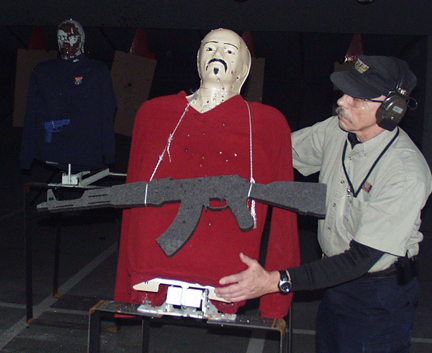 John’s targets to use the plastic Tactical Teds that have been popular for years, but his are designed to fall down when hit with a center chest or head shot. In my role as the Director of the Firearms Academy of Seattle, Inc. I can appreciate a good target design when I see one, and if I didn’t already have a complete array of targets at our academy, I sure would be looking at his (and I may anyway).
John’s targets to use the plastic Tactical Teds that have been popular for years, but his are designed to fall down when hit with a center chest or head shot. In my role as the Director of the Firearms Academy of Seattle, Inc. I can appreciate a good target design when I see one, and if I didn’t already have a complete array of targets at our academy, I sure would be looking at his (and I may anyway).
Tom downplays the match, explaining that it really is just a specific test on one or two aspects of the discipline, and is a fun way to complement the training seminars. This year, trainer Michael Brown (http://www.thepraesidiumgroup.com/) won the match, as he did last year. Though Tom downplays the match, make no mistake: when participants are shooting, they are very serious about it
In the past, Tom has attempted to split the top shooters out into a different category, but this year abandoned the scheme as unworkable. I would suggest to those who have taken the top spot in the past, let’s shoot the match weak handed next time! I am game; I won a previous match. Are you listening, Mike? Or, maybe we could shoot the whole match with a snubby or a couple of snubbies?
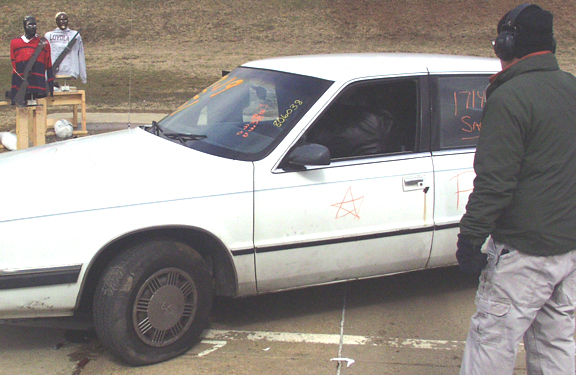 Givens is well qualified to pull this whole event together. He has been involved in this field for virtually his entire life, starting in the 1970’s with early training at Gunsite under Jeff Cooper, until he opened Rangemaster in 1996. He holds the distinction of probably having the highest percentage of students who have used deadly force to save their lives. His student body averages four shootings a year out of the approximately 2000 students per year training with him and with his staff. Memphis regularly makes the “top 10” list of most violent cities in America, which fuels a very great likelihood that the average resident will be a victim of violent crime. In a segment Tom taught at the Tactical Conference, he discussed seven student involved shootings, and explained that there is a one-in-six chance that a resident of Memphis will be a victim of a violent felony crime in any given year!
Givens is well qualified to pull this whole event together. He has been involved in this field for virtually his entire life, starting in the 1970’s with early training at Gunsite under Jeff Cooper, until he opened Rangemaster in 1996. He holds the distinction of probably having the highest percentage of students who have used deadly force to save their lives. His student body averages four shootings a year out of the approximately 2000 students per year training with him and with his staff. Memphis regularly makes the “top 10” list of most violent cities in America, which fuels a very great likelihood that the average resident will be a victim of violent crime. In a segment Tom taught at the Tactical Conference, he discussed seven student involved shootings, and explained that there is a one-in-six chance that a resident of Memphis will be a victim of a violent felony crime in any given year!
I would be remiss if I didn’t explain how to attend the Tactical Conference. First, the conference isn’t open to just anyone, but also isn’t a secret society, either. Tom calls it a “semi-invite” event, meaning that the would-be participant should have a reasonable degree of advanced handgun training before he or she comes to the event. If you have questions I would recommend you call or e-mail Tom to discuss your background. Don’t delay: the event usually fills several months in advance. You’ll find details and contact info at http://www.Rangemaster.com/.
Last, I would like to personally thank Tom Givens for his generous offer to allow me to attend this years event and discuss the Network with the 150 or so fellow sheepdogs at the conference. We had a very warm reception to the idea of the Network, and we look forward to “networking” more in the future.
 Message from the President
Message from the President
By Marty Hayes, J.D.
Last month, I took a little time and explained to you, our new readers and members of the Armed Citizens’ Legal Defense Network, LLC (the Network), the reasons why we decided to form the Network. Since then, we have been working to solidify our ideas for the Network and discuss the concept with some pretty big names in the industry at the Shooting, Hunting and Outdoor Trades convention, the SHOT Show. While it sounds a little melodramatic, the fact is that we respect the privacy of our friends and colleagues in the industry, and so without naming names, I want to share with you some of their thoughts.
Everyone with whom we spoke, received the idea of the Network very warmly. Even those we thought might be naysayers wanted to know how to join! It is nice having as good a reputation in the industry as my wife and I do. While not patting our own backs, we have worked hard to treat everyone we have come in with contact honestly. That work is paying off for the Network, because I don’t get the feeling that anyone who we have talked with is wary of the idea, they just want it to succeed, wish us luck and ask how they can help!
The response we got from some of the major corporate players in the industry, after telling them what we were doing, was REALLY heartening. Several volunteered immediate assistance, and we will surely be taking them up on that, forming a corporate sponsor program for the Foundation and diverting all corporate donations to fund the Foundation.
One of the funniest things occurred when we ran into our friends Kate and Jim Kruger, who run a school in Scottsdale, Arizona, www.tntdefensive.net. They have also opened up a new gun shop, Derby Guns, www.derbyguns.com. (Did you know Mircrosoft word doesn’t recognize the word “derby?”) Anyway, we first met Kate and Jim several years ago in New Hampshire when we went to Lethal Force Institute to do some training with Massad Ayoob, and have kept the friendship with them ever since.
So, to continue with the story, we ran into them getting on the shuttle bus to go back to our hotel. We sat down across the aisle from them and began telling them about the Network and our plans, and the bus got suddenly quiet! Kind of like one of those old E.F. Hutton commercials, “When E.F. Hutton talks, people listen.” I soon found myself explaining the Network to all the people within earshot. At one point, a guy two rows up squirmed over the seat and handed me a “Pre-paid Legal” business card, and said that while he was a member of Pre-paid Legal, he really liked what I was saying, and wanted to know more. That was the type of reception we got everywhere we went and to whomever we talked.
We talked to several magazine publishers, editors and writers, and many have agreed to help get the word out and some of the big name gun writers have agreed to help Gila with the eJournal.
A few notes from the show itself about good self-defense guns and gear: Ruger was promoting a of couple new products that we really liked. One was a short carbine based on the Ruger Mini-14, but with a good ghost ring sight, a stock by Hogue and a 16.5-inch barrel. I don’t know what it will cost, but for those who can’t warm to an AR-15 style rifle, it should be a viable alternative. In addition, Ruger is joining the small concealable semi-auto market with a very small, lightweight polymer pistol. It is very similar to the Kel-Tec .380, and it is my understanding that they were taking orders like mad at the show.
We were also impressed with a new light that “First Light” is introducing, which allows one to use the flashlight easily and also keep two hands on the gun. It is called the Tomahawk, and can be seen on their website, http://www.first-light-usa.com.
I admit we didn’t do a lot of looking at gear, as much as talking to people about the Network.
Closing remarks
As I write this, I have just testified in a local murder trial, where the individual on trial was charged with unlawful possession of a firearm, in addition to being charged with murder. You see, because he is already a convicted felon, the prosecutor wanted to make sure that the jury knew of his past record, which absent a charge directly related to that previous conviction, it cannot be known to the jury.
Our local prosecutor charged him with unlawful possession of firearm. The alleged firearm? A bicycle handlebar stem bolt! A bicycle handlebar stem bolt is about 8 inches long, and is hollow to allow the brake cables to pass through it. Because it is hollow, and a .22 caliber shell could be inserted and “fired” by whacking it with a hammer, they charged him with a being a felon in possession of a firearm. My role in the trial was as an expert for the defense, to identify for the jury that the item in question was a common bicycle part, not a gun. I bring this up as an example how easy it is for a prosecutor to pervert the system.
The Armed Citizens Legal Defense Network, LLC exists to prevent miscarriages of justice, of which the above is just one example. And, while the above referenced felon would not qualify to be a member of the Network, it serves as a reminder how honest, lawfully abiding armed citizens can also be victims of the very criminal justice system they have believed in for their entire lives, if they have a prosecutor who is out to get convictions, as opposed to serving justice.
Until next time…
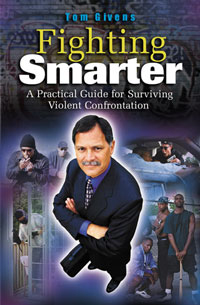 Book Review
Book Review
Fighting Smarter
A Practical Guide for Surviving Violent Confrontation
Third edition
By Tom Givens
There is much to be learned from one who has faced and prevailed against violent criminals. Tom Givens is that kind of resource, listing in his experience making hundreds of arrests, some taking in armed felons, as well as using a handgun to defend himself and others. Stir in the author’s educational background, as both a student of defensive pistolcraft, and as a highly trained instructor, and you’ll find yourself holding a valuable source of information. This knowledge and experience is the foundation of Tom Givens book, “Fighting Smarter.” Although my copy is a first edition, the work is now in its third <?>revision/edition.
In his introduction, Givens’ stated goal is strengthening the reader’s mental fitness preparatory to self-defense, which he expresses, “I sincerely hope this book will make you think about your personal security and how to achieve it. The mental skills involved in gunfighting are more important than the physical skills, and the mental skills require personal effort, just like learning the physical skills.”
Givens boldly suggests that arming ourselves may be our “social duty,” in light of the sobering crime statistics he goes on to quote. Citing the infrequency of death from lightening strike, he underscores the pains exercised to avoid this sort of mishap. Since death by violent means is so much more prevalent, it seems senseless not to have means to protect ourselves.
Acknowledging that sometimes local laws impede carrying a gun for self-defense, this author first advises, “Move.” Next option? Political activism, but no where does he even suggest that it is better to be prepared to fight back at the expense of breaking the law. This author is apparently no fan of the “better tried by twelve than carried by six” thinking we sometimes run into in armed circles.
Where it is legal to carry, society and government expect more of the armed citizen, holding him or her to a higher standard of behavior in the face of traffic disputes, drug or alcohol use, anger management and more, Givens adds. In addition, going armed does not invest you with any duty to break up fights, thwart robberies or intervene elsewhere. “The key is to reserve any use of your firearm to situations in which YOU OR A KNOWN INNOCENT THIRD PARTY IS UNDER LETHAL ATTACK,” emphasizes the author.
The chapters that follow wend through a wide range of topics essential to the armed woman or man. These include reviews of use of force, and the force continuum. This progression ends with these sage thoughts: “All of this looks terribly complicated on paper, but it is not. These situations can be sized up, evaluated, and acted on in the blink of an eye, but ONLY IF you study the problem now and make a firm commitment to using force only when and to the degree necessary to protect you or a loved one.” He urges prior thought, and adopting this credo:
“1. I will not seek a fight, and if at all possible I will avoid one, but if one is forced upon me I will do what ever it takes to survive.
2. My sidearm is neither a status symbol nor an emotional crutch. I will not reach for it unless out of dire necessity, but if I must use deadly force to preserve my life or that of an innocent person, I will use it skillfully and without hesitation.”
A good vow for any armed person to take! These thoughts are representative of Givens’ approach to going armed, and this alone makes Fighting Smarter a great introductory book to give friends or family who may be considering getting a gun for self-defense. The author’s attitudes are so diametrically opposed to the trash talk too often heard at gun shows and other places where firearms hobbyists gather and brag that they would do this or that, leaving many in the general public worried that concealed carry legislation, or even our most basic rights to own guns may lead to gunfights in the streets! Givens’ book is a great antidote to such foolishness.
A BOOK FOR BEGINNERS?
Givens’ book is full of valuable gems of information, mindset and viewpoints in for readers whether they have been a gun owner for four days or for four decades!
For the beginner, Fighting Smarter is full of the wisdom and knowledge of someone who has lived the armed lifestyle for years. The author often builds on concepts from his early training at Gunsite with luminary Col. Jeff Cooper.
In discussing Condition Yellow (not sure what that means? Get “Fighting Smarter,” and find out!), he compares unthreatened levels of alertness to military craft, in which radar continuously scans, whether or not any threat is apparent. A blip on the radar is not immediately shot down, but checked out and given the appropriate response.
Givens dedicates chapters to gun safety, proper equipment like guns and holsters, training for and understanding the necessary skills, ammunition choices, gun maintenance, shooting technique, appropriate use of pistol sights, dryfire and much more.
Though these topics may be new ground for introductory-level readers, experienced shooters will also enjoy Givens’ explanations, and probably find themselves borrowing from his store of knowledge the next time they are asked about guns.
A BOOK FOR EXPERIENCED GUNNIES
For the experienced shooter, Givens shares his understanding of the criminal mind, patterns of attack and managing fear and physiological response during an emergency, gathering and using intel. He teaches that “we wear a sidearm in order to regain control of our environment in an unexpected emergency. We cannot control our environment unless we can control ourselves!” he concludes. In addition, I learned much from the chapters dealing with pre-aggression indicators, and found his views on victim behavior unique.
On taking steps to avoid becoming a victim, Givens recommends a study of crime reports, with an eye to what the victim did that brought them under the criminal’s power. “Very soon, you will recognize the behavior or activity on the part of the victim that facilitated or even precipitated the crime,” he writes. “Once you have identified the specific victim behavior that caused the attack, you are reinforcing in your subconscious that this is negative or harmful, behavior.”
Later, he adds “Violent behavior on the part of others is usually triggered by either aggressive or submissive behavior on your part...Why? Because the submissive person is the natural prey of the aggressor. Predators don’t hunt predators.” A short checklist of submissive behavior follows, and the chapter ends with a good description of assertive actions. Armed or not, Chapter 8 should be considered essential survival training for anyone who does not wish to support their local criminal element!
This kind of forthright honesty requires courage on the part of the author, and a willingness to engage in truthful self-evaluation on the part of the reader!
So many portions of Fighting Smarter caught my attention and made an impact on my thoughts that it is tempting to recite entire portions of the book. That, of course, is neither practical nor fair to the author. Suffice it to say, you need this book. First for your own enjoyment, than as a prime loaner book for all who come to you with their gun, shooting and self-defense questions.
___
Fighting Smarter: A Practical Guide for Surviving Violent Confrontation
Third edition
By Tom Givens
234 pages, with illustrations
$27.95, plus $4.00 shipping
Order directly from Rangemaster. Phone 901-370-5600, or fax 901-370-5699 or email
Remembering Jim Cirillo
By Marty Hayes
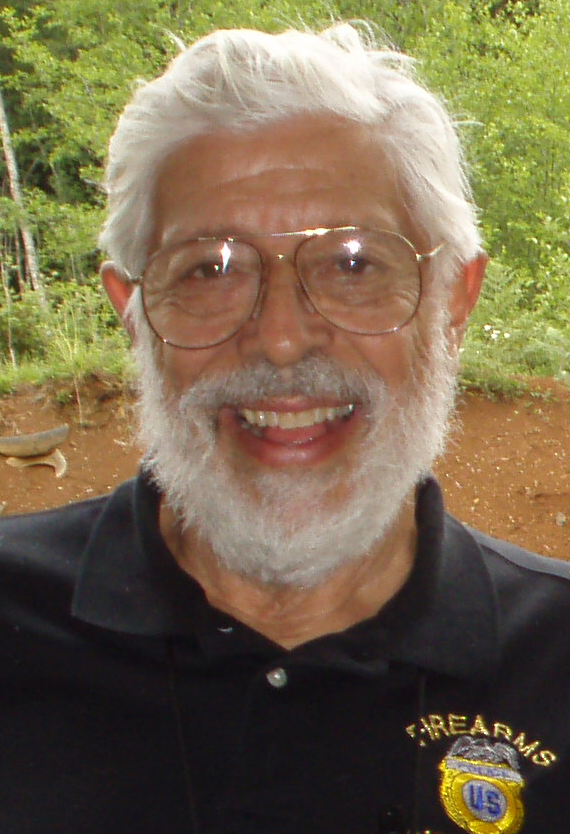 It is with a heavy heart that I start this remembrance. By now, most people in the gun culture know that we lost a great man last year when Jim Cirillo was tragically killed in an auto accident. It is particularly difficult for me to discuss this loss, as Jim was a very good friend and mentor. Of course, life is full of losses such as this, and while it doesn’t hurt any less, as I get older and deal with losses like this, I at least gain a perspective on life and realize that we should live each day like it may be our last, because the grim reaper CAN visit at anytime.
It is with a heavy heart that I start this remembrance. By now, most people in the gun culture know that we lost a great man last year when Jim Cirillo was tragically killed in an auto accident. It is particularly difficult for me to discuss this loss, as Jim was a very good friend and mentor. Of course, life is full of losses such as this, and while it doesn’t hurt any less, as I get older and deal with losses like this, I at least gain a perspective on life and realize that we should live each day like it may be our last, because the grim reaper CAN visit at anytime.
About 15 years ago, I first met Jim when he came out to the Seattle area at my invitation, to teach a series of classes. Not only did the classes go well, but Jim and I formed a bond that lasted until his death, which occurred only two weeks after his last visit to our home. During that last visit, he and his, son, Jim Cirillo Jr., taught two classes, and as fate would have it, these lucky students were his last. I hope they appreciate that.
Elsewhere in this issue of the Network eJournal, I write about a gathering of sheepdogs. Well, Jim was the ultimate sheepdog, fulfilling that role as a member of the New York Police Department, and when he was selected to join the Stake Out Unit. Jim’s work in the Stake Out Unit is the stuff legends are made of, and others, including Jim himself, have written about his days on the Stake Out Unit.
What most people don’t know, is that when the Stake Out Unit was disbanded, the NYPD put Jim out to pasture, by relegating him to a quiet beat with no action. You see, while the NYPD brass liked Jim when he was stopping armed robberies at the point of a gun, when the smoke cleared, they were afraid they had a monster on their hands, someone willing to kill at the drop of a hat. Of course, anyone who knew the man knew this wasn’t true, but nonetheless they wanted Jim to go away.
Well, Jim did go away, retiring as soon as he could from NYPD, and taking a job with the Federal Law Enforcement Training Center, where he became a trainer of sheepdogs. A fitting move, and for the next 10 years, Jim trained a few thousand more federal law enforcement officers to be the protectors of the sheep. At the 10-year mark, Jim retired from federal service, but he didn’t slink away. It was at this time that I met Jim, as he started his third and final career, now as a private trainer, taking his message to the armed citizens of America.
Jim’s classes were a mixture of marksmanship principles, tactical awareness and advanced shooting techniques, with a few stories about his gunfights thrown in during breaks. In the hundreds of students Jim taught for us, I can never remember any student going away dissatisfied. After all, they had just trained with the Wyatt Earp of our generation.
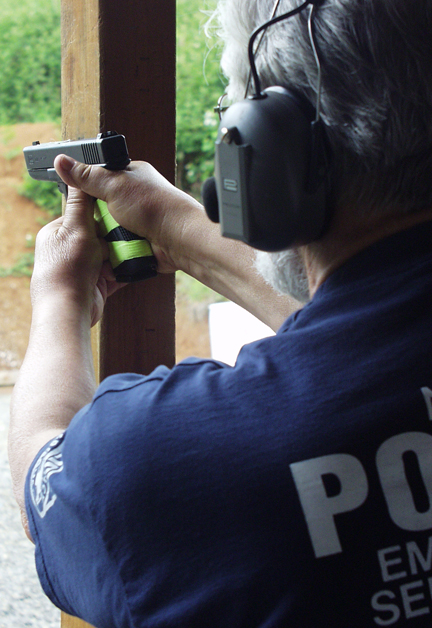 Jim was best known for getting people shooting from unconventional positions, a lesson he learned while working for NYPD. He once related to me the story of one of his brother officers who was knocked down on his back, and because that officer had never drawn his gun from any position other than standing, simply didn’t know what to do, and lost his life because of it. After that, Jim developed and started teaching his “Downed Officer Defense Course” which had the student shooting from a variety of positions, such as on his back, on his side or even upside down.
Jim was best known for getting people shooting from unconventional positions, a lesson he learned while working for NYPD. He once related to me the story of one of his brother officers who was knocked down on his back, and because that officer had never drawn his gun from any position other than standing, simply didn’t know what to do, and lost his life because of it. After that, Jim developed and started teaching his “Downed Officer Defense Course” which had the student shooting from a variety of positions, such as on his back, on his side or even upside down.
The other shooting technique for which Jim will be remembered eschewed the common police technique of switching the pistol to the weak hand, when shooting from around weak side cover. Jim believed that under the reactive stress of a gun battle, one would not switch from the strong hand to the weak hand, and I believe him to be correct. His technique is to keep the handgun in his strong hand, and simply lean out around weak side cover, canting the handgun away from the cover, so either the cylinder of the revolver cleared the cover, or the slide was tilted away so the brass would eject without getting caught in the ejection port.
One of the things I respected most about Jim as a trainer was his willingness to explore new techniques, and embrace them if they made sense to him. Always a proponent of sighted fire, he became convinced that in close range engagements, point shooting was more likely to win the day. Consequently, he developed his system of point shooting, for use along with alternative sighting techniques which most trainers in the business use one form of or another.
 Over the last several years, Jim’s son started accompanying him on his teaching trips, with the idea that with the help of Jim Jr., he could continue teaching longer despite shoulder and knee joint problems. His untimely death has left a void in the industry, which will not be filled anytime soon.
Over the last several years, Jim’s son started accompanying him on his teaching trips, with the idea that with the help of Jim Jr., he could continue teaching longer despite shoulder and knee joint problems. His untimely death has left a void in the industry, which will not be filled anytime soon.
During his last visit, I asked him if he would serve on the advisory board for the Foundation, and he enthusiastically agreed. When he was killed, I waited an appropriate amount of time and asked his son, Jim Cirillo Jr., to fill the spot we had reserved for his father, and he said he was honored to do so. Jim Jr. has said he wants to help keep alive his father’s memory, along with his training techniques, and we are very supportive of that effort. Welcome to the club, Jim Cirillo, Jr. and thank-you for serving in your father’s shoes.
DEFENSE IS MUCH MORE THAN THE GUN!
By Gila Hayes
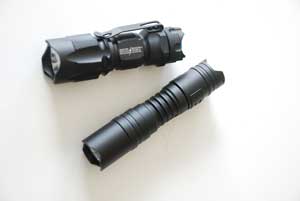 A compact but very bright flashlight is a piece of equipment without which I never leave home. The light is as important to me as my handgun, and frankly, it sees a lot more use (thank goodness)! I am fanatical about having very bright light. At half-a century of age, the struggle to see sharply is greatly exacerbated in low light. For that reason, I discarded quite a few of the earlier LED flashlights after finding I just couldn’t make quick, decisive identifications or observations at ten yards and out.
A compact but very bright flashlight is a piece of equipment without which I never leave home. The light is as important to me as my handgun, and frankly, it sees a lot more use (thank goodness)! I am fanatical about having very bright light. At half-a century of age, the struggle to see sharply is greatly exacerbated in low light. For that reason, I discarded quite a few of the earlier LED flashlights after finding I just couldn’t make quick, decisive identifications or observations at ten yards and out.
For years, of course, Sure•Fire was the major source for compact, bright lights. Streamlight has unquestionably held a strong second place not owing to any product deficiencies, but rather due to the glamorous “tactical” image that personified Sure•Fire so early in the development of the small, personal flashlight. Other manufacturers also marketed products, but the lights often lacked user friendly switches, intuitive on/off and momentary controls, and just didn’t capture the imagination of a demanding marketplace.
Those early personal/tactical lights were power hogs, with the incandescent bulbs voraciously consuming their 123A lithium batteries. Relief from expensive batteries is just one selling point for the new generation of LED tactical lights. A considerable gain in durability has proven another major benefit.
With these factors in mind, our today challenge is less focused on finding lights that are durable, efficient and ergonomic, but rather picking the best from among the many offerings. Folks with a bent toward the technological hang out on Internet sites like www.candlepowerforums.com. There, the reader finds instructive discussions about different brands of LEDs, how different manufacturers measure the light output and the noteworthy fact that there is no standardization on how light output is measured, so a manufacturer claiming 180 lumens may sell you a product that gives off less light than another brand that touted 120. Buying a tactical flashlight deserves a little study, since interpreting the claims on the packaging is more than a comparative study.
At this year’s Shooting Hunting Outdoor Trade (SHOT) Show, the big industry convention we attend every year, there was no shortage of flashlights marketed for outdoors enthusiasts, law enforcement, and individual tacticians. To review even the best of show would be a gargantuan undertaking, along the lines of Kathy Jackson’s 2005 Flashlight Compendium published at www.equipped.org. Absent such ambitions, we brought home two lights that appealed to us personally, and for varied reasons.
BRITE-STRIKE LIGHTS
Several years ago, two Massachusetts cops began developing their own line of tactical flashlights, in hopes of improving user ergonomics like improved clips to carry the light for faster access, activation switches that are intuitive, and fitting the shape of the light’s barrel to the human hand. The year and a half old company now has a solid product line of some 8 or 9 models, including a powerful one battery LED light (Mdl. RL180-MH-1C retailing for $150) that has displaced the E2D Sure•Fire Defender from its long-held place in my little black bag. If I can coerce a leather-making friend to create it for me, I intend to clip this little light on to a simple loop snapped to my belt, positioning it horizontally. On body carry is always preferable, eliminating the risk of not having the light at hand when it is needed.
Whether we go with the one battery version or the two battery light from Brite-Strike, nice features include a deeply fluted flashlight head that gives the hand a better hold, as well as three flats cut into the tube of the light, roll-proofing it. The flashlight is sealed with O-rings for waterproofing and has been shock-proofed.
The tail cap extends above the on/off switch to prevent inadvertent activation. It is also fluted, with the same coarse checkering that is present on most of the rounded surfaces of the rest of the light.
A sturdy clip keeps the light securely in a waistband or pants pocket, where it is carried with the light down for quick access by the non-dominant hand in a strong overhand grasp for searching, or one handed shooting or in one of the several light and gun stance, should time and non-dominant side cover accommodate. Bearing the mark of a light designed by people who use tactical flashlights, this light’s clip is in what they’ve called reverse position to encourage getting the right grasp on it immediately. For uniformed personnel, the clip is also convenient for attaching the light to an epaulet for additional light during activities that require both hands.
Brite-Strike’s Blue Dot Series of lights use Phillips Lumiled Luxeon® LEDs that claim 100,000 hours of burn time, and a maximum output of 180 lumens. At the opposite end, the soft pressure switch has the momentary on capacity, with a locking “on” switch available with more pressure. An additional click deactivates the light. Though not present on my model, different versions offer strobe capability, as well as high beam and low light output options, handy for tasks like reading a map or jotting a note in a dark car where the high setting leaves you all but blind after extinguishing the light.
Finally, and I intentionally mention it last, because it isn’t a feature that would close the sale for me, the Brite-Strike lights have the crenellated strike head that has become de rigueur on personal tactical flashlights of late. In a fight, any tool becomes a weapon, and the presence of the strike head certainly takes nothing away from the Brite-Strike product.
For more information contact:
Bright-Strike Technologies
Jones River Industrial Park
26 Wapping Rd, Rt. 106
Kingston, MA 02364
781-585-5509
www.brite-strike.com
Tech Details
Brite-Strike RL180-MH-1C
Weight 3 ounces
Dimensions 3.5” L x 1.48” W
Maximum light output 180 lumens
Control functions Momentary and Constant-On
1 hour constant run time
Battery 1 123A Lithium
Suggested retail price $150
Mixed Feelings for Ladies’ Lighting System
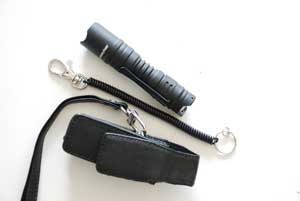 I’m personally somewhat suspicious of “ladies” versions of defense or utility gear, so when Brite-Strike owners Glenn and Sarah Bushee and wanted me to review their Lightening Strike Personal Protection System, I admit I was skeptical.
I’m personally somewhat suspicious of “ladies” versions of defense or utility gear, so when Brite-Strike owners Glenn and Sarah Bushee and wanted me to review their Lightening Strike Personal Protection System, I admit I was skeptical.
After studying the little black box containing a flashlight, case, battery, lanyard and 100-decibel alarm, I recognize that for the right customer this little package has a lot of value. Not everyone demands a light that can show what is going on at the other side of the parking lot. Instead, this package focuses on folks who are not hard-core fighters, for whom carrying a light is better than having no preparation whatsoever.
The light’s tail cap is designed for the ladies who wear longer fingernails, with just two finger-sized slots so long nails don’t impede the finger’s access to the switch. The ladies flashlight package uses a conventional penlight battery, which is great for the budget, too.
Before giving the impression that this is a low-end unsophisticated light, let me point out that the Lightening Strike has a high setting, low setting for about 20 lumens of light, and a 60-lumen strobe setting available. Unfortunately, the switch does not allow the momentary on function so useful for illuminating an area being searched, then moving quickly away from the position the light last identified you as occupying.
Also in the package is a coiled lanyard with a snap swivel, plus a black leather holster with a wrist strap. The light itself has a metal clip if you prefer to clip it in a waistband or pocket. It all but eliminates excuses for not having a flashlight available!
Brite-Strike’s president, Glenn Bushee, developed both the Lightening Strike system and a teaching curriculum that goes along with it for use in awareness and self defense classes he teaches primarily to women. Dubbed the “Flash, Bash and Dash” system, it focuses on alertness to surroundings, avoiding places that compromise safety, but discusses how to manage less safe places like enclosed parking garages. This package, at an affordable $79, would be a perfect companion to general safety programs like the NRA’s “Refuse to be a Victim,” targeting a market with little or no grasp of personal defense as an entry point to bring them to a place of greater awareness and preparation.
As one might expect, parts of the Flash, Bash and Dash class advice seems watered down to me, and I was especially disturbed by the warning against using the strike head in an assailant’s face for fear of retributive lawsuit. Still, absent that complaint and my concern that the light lacks a momentary on capability, by and large the Lightening Strike is a fine product made all the better by its associated training information.
The full line of Brite-Strike’s lights is available for order on line at www.bright-strike, and some models are sold on-line in the Harrington catalog, as well.
___
FIRST LIGHT TOMAHAWK
 “Tomahawk: a light ax formerly used as a tool or weapon by certain Native American peoples.” –MS Word’s dictionary
“Tomahawk: a light ax formerly used as a tool or weapon by certain Native American peoples.” –MS Word’s dictionary
I wonder if the folks at First-Light USA saw the word play between their product and this definition when they named their latest lighting product the “Tomahawk.” The idea pleases me, although it was probably the substantial head of the flashlight atop the vertical battery compartment that reminded them of a tomahawk. In either case, First-Light’s newest product is indeed a light weapon in its own way, with a colorful, descriptive name, and a lot of great features going for it.
But let’s back up a little. I first learned about First-Light USA in 2006 when our friend Clyde Caceres departed the Pacific Northwest to take a new position with an Illinois manufacturer of tactical lights. Before long, a little package arrived and we had the chance to test drive First-Light’s Liberator hands-free tactical light.
Though the Liberator has been enthusiastically embraced by operators like the K-9 officers of the US Border Patrol, I found it difficult to set up, hard to transition between long gun to handgun and just generally too complex.
Clyde is “Mr. Enthusiasm,” with boundless zeal, so I looked forward to a visit to the First-Light booth at SHOT Show to check things out and hear the latest from him. When I saw Clyde, however, I was surprised to see something different than a Liberator on his hand. Looped to his finger, instead, was an extremely rugged little light. This was the Tomahawk, and I was immediately fascinated.
First-Light’s rallying cry from the beginning has been the modernization of flashlight technology to abandon what Clyde calls “tube-lights,” the conventional flashlight comprised of a tube with the bulb at one end, batteries inside and a switch somewhere on the tube. Instead, First-Light borrows the angle-headed Fulton flashlight model, though considerably scaled down and using modern materials and technology.
Light emitting diodes (LEDs) and the small circuit boards that control them, move from the Liberator design to the Tomahawk, but this one is wonderfully simplified. All the controls are easily operated with the weak-hand thumb, and very quickly understood, whether you read the instruction sheet or not!
Just three buttons provide all the options. To the left is the constant on/off switch, and to the right is the intensity and strobe option switch, on my test model, the Tomahawk ST. At the rear of the pressure pad is a wide, curved activation bar for momentary activation. It is simple and ingenious. When the light is in constant on mode, pressing the right switch steps brightness down through three intensities then back to high. If the light has not been put into constant on mode, holding down the right side button activates the strobe.
By threading the index or middle finger through the Tomahawk’s carry loop, the light points forward when the lower three fingers are closed around the dominant hand and the grip of a handgun. The control pad remains under the thumb, ready for a momentary blaze of light, the strobe, or to put it into constant on mode.
The hand-held Tomahawk obviates all the safety and legal problems that accompany the gun-mounted light, because the weapon can be lowered to a depressed low ready position, while the hand with the Tomahawk is free to beam the light through the area under inspection without concern about pointing the gun at innocents.
Reloads, malfunction clearing, and other gun handling is not inhibited by the Tomahawk, so never again, need we stuff a flashlight in the armpit, crook of the neck or into a pocket while returning the gun to shooting condition.
Early queries, my own included, wondered why the battery compartment of the Tomahawk wasn’t skinnier, since it is .60-inch across, compared to the .46-inch measurement of its 123A battery. Clyde explained that one of the prototypical designs had a skinnier battery compartment, but it turned out that changing batteries entailed screwing off the entire head of the light, and thus disrupting the finger loop and the MOLLE clip. Deeming that too slow and disruptive, the next design featured a fatter tube to accommodate the threads of a screw on base cap.
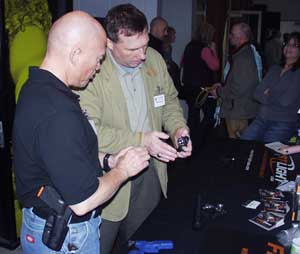 MORE THAN JUST SHOOTING
MORE THAN JUST SHOOTING
As I opined at the beginning of this discussion, the flashlight is a tool that, though carried with tactical concerns in mind, is used regularly to light the path to the garage, check to be sure the dog is in his kennel, or to simply find the house key among all the rest on the ring. The angle head design of the Tomahawk proves extremely convenient, since it can clip to a belt or lapel giving good light for jobs as simple as carrying in a big load of groceries.
Clyde expects the Tomahawk’s market to go far beyond armed citizens, police and military. When last I visited with him, he had recently been contacted by a supplier to the pest control industry, so wanted to stock Tomahawks for pest control personnel who frequently use flashlights in their jobs.
FEATURES AND OPTIONS
In addition to the removable finger loop, the Tomahawk is equipped with a retention clip so it is easy to slip the clip into a trouser or shirt pocket when all you need is a beam of light illuminating what is ahead of you. The clip is designed to work with MOLLE gear, and is, perhaps what the anemic Pentagon Molle light should have been. The clip, like the finger loop, is easy to rotate into just the right angle.
Though the clip is heavy-duty steel, the finger loop is designed to flex or to break away if someone or something grabs the light. Broken fingers or worse could result, so First-Light decided to make the loop a bit more fragile.
First-Light makes six variants of the Tomahawk. The standard model has three brightness levels, with a maximum output of 80 lumens. The GP model puts out 120 lumens and is built to military specifications. The ST, discussed here, features the Ready-Strobe® capability, plus the three brightness levels, maxing out at 120 lumens. The MC model also has a maximum 120 lumens output, and adds a ring of colored LEDs in red and blue, or in red and green around the outer edge of the reflector. The LE model is similar, but has a strobe and a red-blue-white emergency flashing feature.
Techies will want to know which kind of LEDs go into the construction of the Tomahawk. When asked, Clyde answered that it varied depending on the application. They use Crees, Seouls, and Lumileds, with the different diodes chosen for best applicability to the light model.
Prices for the varied models run from $129 to $219 depending on features.
Tech Details
Tomahawk ST
Weight 5.6 ounces
Dimensions 3.35” H x 2.38” L x 1.48” W
Maximum light output 120 lumens
Control functions Ready-Strobe
Momentary
Constant-On (3 levels)
Battery runtime 2 hours (highest setting)
60 hours (lowest setting)
Suggested retail price $169
Editor's Notebook
By Gila Hayes
One of the points we studied long and hard during the formative period prior to launching the Armed Citizens Legal Defense Network, LLC (the Network), was the expenses of serving a member for one year weighed against the value of the varied benefits of membership. In the end, we settled on $85, and it seems to be a reasonable exchange, based on feedback I’m getting from members and potential members.
When several members made amusing comments listing other things on which they might have spent that $85, it started me thinking.
$85 pays the cable TV bill if you get the extra movie and sports channels. It will also buy a ticket to a football or basketball game. An inexpensive pitching wedge for your golf game may be found for $85, but you can also expect to spend that much to get on the golf course for a nice day of playing (cart rental extra). You could buy a tennis racket, a used 10-speed bicycle or a second hand snowboard with the same amount.
Depending on your rig, $85 will buy a tank or two of fuel, or two oil changes. It will, however, only buy one of the four mud tires you may need to get through the spring rains! You could buy tickets for a one-way commuter flight between Portland, OR and Boise, ID for $85, or spend about that much to change your pre-purchased airfare for another trip.
It will buy a mid-priced pair of shoes, if your tastes are simple, or a nicely lined case for your side-by-side shotgun. Again depending on taste, it is good for a pair two of jeans, a sweater, and maybe even a jacket. Adopting a pet from the Humane Society costs around $85 these days, and just try to get in and out of the yard and garden nursery without coming up at least $85 poorer.
Few things whittle away at our discretionary cash as a trip into the home-improvement store. Just the other day, I found a DeWalt reciprocating saw for $85 and thought it was a good bargain, but then I saw the Ryobi router for the same price, next to the angle grinder for about the same sum, plus a marked-down orbital sander, and a full-price skil saw, all in the same price range. So many tools…so little time.
$85 will buy a very good dictionary, or, if you practice self-control fund a trip to the bookstore for about three hardcover books. With it, you could also buy a 2- way paper shredder. You can buy several DVDs of your favorite movies with $85, or pay your Netflix bill for about four months with those same four “Andrew Jacksons” plus one “Lincoln.”
A nice dinner for two can eat up $85 pretty quickly, but then a prime rib roast for a big family dinner will cost that much alone. A bottle or two of your favorite alcoholic spirits, depending on what you drink can go well over $85, and it isn’t hard to blow $85 on a night out partying, a visit to the casino, even a day trip sight seeing to the beach, or the “big city.” You can have a dozen roses delivered for around $85, or she may spend that much or more on a visit to the spa for a facial, manicure or haircut.
I could go on, but I think you see where I am taking this line of thinking.
Whether we buy a gun, ammunition, training, a book on tactics, a DVD of a lecture or a holster, we make an investment in our future, and very possibly in our future safety and well-being. Fortunately, it is pretty easy to add up some pretty substantial benefits from your $85 yearly membership dues.
With your $85 Network membership secured, you can get 10% off classes through any of the Network-affiliated instructors and schools who choose to support the Network in that fashion. In these early days, those instructors include David Blinder, Andy Kemp and Bob Houzenga, and The Firearms Academy of Seattle, Inc. We are confident that as our instructor membership grows that more training organizations will see the benefits of offering tuition discounts, so this list will only grow.
As soon as they are ready, you will receive a multi-disk DVD set with information and instruction on handling the legal aftermath of a self-defense incident. With videos like this priced at $35 to $60 each through outlets like Police Bookshelf, Gun Video and Paladin Press, it isn’t difficult to quickly recoup a good percentage of the membership fee. Other educational and informative information comes to you in the monthly eJournal, something we find priced from $5 to $20 for the electronic publications of hobby groups online.
As our Network structure grows, members will save time and money with direct access to lists of lawyers and legal experts who know how to defend the self-defense use of force. While less tangible, the ability to apply for a grant of financial assistance from our sister organization, the Armed Citizen’s Legal Defense Foundation may well be the most valuable altogether. We are skimming $17 off of each $85 membership dues payment and putting it directly into a foundation, overseen by an advisory board consisting of field leaders like Tom Givens, Massad Ayoob, John Farnam, Jim Cirillo, Jr., and others to be announced as they agree to serve.
Network membership is a mix of tangibles and intangibles, benefits currently available and benefits that we are still developing. All of our initial members, as well as those currently responding to membership promotions are being given extended memberships through the 31st of May, 2009 to be sure they get their money’s worth.
And that is what it all comes down to. Are these protections, education, and benefits worth as much as a Ryobi router, a floral bouquet or dinner out? You’ll have to decide for yourself.
